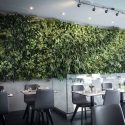Springing to Life: Tracing Biophilic Design’s Roots and Its Easter Renaissance
Biophilic design is a modern approach to interior design that aims to bring people closer to nature within indoor spaces. Inspired by the principle of biophilia (the love of all living things), it incorporates natural elements into architectural and interior design.
With businesses emphasising well-being and productivity, it’s essential to grasp the principles and advantages of biophilic design. This blog delves into how biophilic elements can enhance interior spaces, using Easter as inspiration to evoke our innate affinity for nature. By understanding these design principles, interior designers can create spaces that stimulate and refresh, aligning with our natural connection to the environment.
Understanding Biophilia
Biophilia: An Innate Love for Nature
Biophilia is a concept that refers to the innate human connection with nature. It was coined by biologist Edward O. Wilson in his 1984 book “Biophilia.” This concept suggests that humans have a natural inclination to interact with the environment and other life forms. Wilson argued that this connection has developed over millions of years of evolution and influences our preferences, actions, and emotional and physical reactions to the natural world.
Historical Context and Evolution of the Concept
For ages, people have believed in a natural connection between humans and the environment. Philosophers and writers have emphasised how important nature is to us. But it was E.O. Wilson‘s idea of biophilia that made this connection a scientific idea. Biophilia is the scientific idea that humans have an innate love for nature. Wilson said that being around nature could help people physically and mentally. Since Wilson introduced the idea of biophilia, psychologists, biologists, and architects have looked into it further. They have found that this natural connection affects things like health, happiness, and creativity.
Scientific Basis for the Human-Nature Connection
The idea that humans have an inherent connection to nature, known as the biophilia hypothesis, is supported by scientific research. Studies in environmental psychology show that being in natural settings can lower stress, improve mood, and boost mental performance. Elements like green spaces, the sound of water, and natural light all contribute to feelings of relaxation and well-being. Furthermore, neuroscientists have found that certain patterns and shapes commonly found in nature, called fractals, have a calming impact on the brain, providing additional evidence for the biophilia hypothesis.
Biophilia in the Modern World
Even with the rise of technology and cities, being close to nature is still essential for our well-being. However, in urban areas where green spaces are scarce, it can be challenging to connect with nature. That’s where biophilic design comes in. It’s a set of guidelines that helps us incorporate natural elements into our buildings and spaces to improve our health and happiness.
The Foundation of Biophilic Design
It’s important to know about biophilia when planning biophilic designs. Biophilic design aims to connect with our deep-seated love of nature by creating spaces that are naturally more balanced, refreshing, and good for our well-being. When we include our inherent love of nature into the design of our surroundings, we can make environments that show our genetic link to the natural world, which makes us feel calm and happy.
The Birth of Biophilic Design
From Theory to Practice: The Evolution of Biophilic Design
The move from the idea of biophilia to using biophilic design in practice was a big step forward in architecture and interior design. While the idea of biophilia showed that we have a natural connection to nature, it was using these ideas in biophilic design that showed how good it is to put nature into our buildings. This change was helped along by people who saw how important these ideas could be in changing how we design spaces.
Pioneers and Key Figures
Stephen Kellert, a social ecologist who worked with Wilson, made significant contributions to the advancement of biophilic design. Kellert extended Wilson’s biophilia theory to architecture and design. He established practical strategies for integrating biophilic elements into building environments, such as utilising natural materials, and lighting, and incorporating living plants and water features. Kellert’s research provided the foundation for a comprehensive approach to design that acknowledges the innate human desire for connection with the natural world.
Landmark Studies and Contributions
Through research and examples, the effectiveness of biophilic design principles has been proven. Studies have shown that incorporating elements of nature, such as plants, sunlight, and outdoor views, in workplaces leads to increased productivity, reduced stress, and improved employee well-being. In the hospitality industry, hotels and resorts that utilise biophilia report increased guest satisfaction, especially in terms of relaxation and overall experience. These findings highlight the practical benefits of biophilic design in creating environments that not only enhance aesthetics but also contribute to physical and psychological well-being.
Principles of Biophilic Design
Biophilic design is built on a set of principles that guide the integration of natural elements into architectural and interior design. These principles include:
- Visual Connection with Nature: Incorporating elements that provide a direct, meaningful experience of nature.
- Non-Visual Connection with Nature: Engaging other senses through the sound of water, the smell of plants, or the touch of natural materials.
- Presence of Water: Utilising water features to create calming and restorative environments.
- Natural Materials: Using materials that reflect the local ecology or mimic natural textures and patterns.
- Light and Space: Designing spaces that mimic the natural environment through the use of natural light and open, airy layouts.
- Refuge and Prospect: Creating spaces that offer feelings of safety and shelter while allowing views of the surrounding environment.
The Impact of Biophilic Design
Biophilic design doesn’t just make spaces prettier. It has major health, mental, and financial benefits. It helps us feel more connected to nature, and it can make our homes and offices more environmentally friendly, relaxing, and healthy. As people learn more about these benefits, biophilic design is becoming more and more important in building and designing spaces that are eco-friendly and focus on human needs.
Biophilic Design and Easter: A Seasonal Perspective
Easter: A Time of Renewal and Rebirth
Easter, a time of renewal and rebirth, offers ideas for designs that connect people to nature. Like the awakening of nature after winter, Easter represents the rejuvenation of life. Biophilic design, which seeks to inspire and revitalise through nature’s influences, shares these principles. By incorporating Easter’s colours and symbols into interior designs, biophilic design can help create a stronger connection to the natural world.
Incorporating Easter Themes into Biophilic Design
- Colour and Light: Easter’s palette—soft pastels, vibrant greens, and the bright yellows of daffodils—can be integrated into spaces to mirror the season’s renewal. Natural light, accentuated in design to mimic the longer, brighter days of spring, can invigorate office spaces and hospitality settings, enhancing mood and well-being.
- Plant Life and Flowers: Just as Easter is celebrated with the bloom of spring flowers, biophilic design can incorporate seasonal flora to breathe life into interiors. Living walls, potted plants, and floral arrangements featuring Easter lilies, tulips, and hyacinths can transform spaces, making them feel more alive and connected to the season of rebirth.
- Symbols of New Life: Easter symbols such as eggs, which represent new life, can inspire design elements that evoke a sense of renewal. Curved forms and organic shapes in furniture, artwork, and architectural features can subconsciously echo these symbols, fostering environments that feel nurturing and invigorating.
Enhancing Well-being Through Seasonal Biophilic Design
Integrating Easter and springtime themes into biophilic design not only aligns with the aesthetic aspects of the season but also taps into the deeper psychological effects of witnessing renewal and growth. This alignment can enhance the well-being and productivity of individuals by:
- Reducing Stress: The incorporation of natural elements and seasonal themes can create a calming environment that reduces stress and promotes relaxation.
- Boosting Mood: Colours, light, and plant life associated with Easter and spring can elevate mood, offering a sense of optimism and rejuvenation.
- Encouraging Creativity: The symbolism of rebirth and new beginnings can inspire creativity, encouraging occupants of the space to think innovatively and embrace new ideas.
Embracing the Essence of Biophilic Design and Its Seasonal Symphony
From its origins to its practical applications, biophilic design reveals the interweaving of our innate love for nature and our built environments. By connecting this concept to Easter’s themes of rebirth and renewal, we highlight the transformative power of incorporating natural elements into these spaces.
Summarising Biophilic Design’s Roots
Biophilic design is not just about making things look nice. It’s based on the idea that people have a deep need to be connected to nature. This has been studied by scientists like Edward O. Wilson. Biophilic design is being used in modern buildings and interiors to improve people’s health, happiness, and work-life. Examples in offices and hotels show how creating spaces that reflect our natural instincts can lead to better lives and a more sustainable world.
The Future of Biophilic Design
Biophilic design, with its focus on incorporating natural elements, can help address challenges like urbanisation, environmental damage, and the pursuit of sustainable living. By including seasonal and themed elements, such as those inspired by Easter, biophilic design becomes flexible and responsive. It improves not only the physical spaces we use but also our mental and emotional health.
Biophilic design holds immense potential to revolutionise and uplift spaces. As its benefits become widely recognised, we expect more widespread adoption of biophilic principles in homes, businesses, and public areas. This transformation will involve increased use of sustainable materials, creative utilisation of technology to create lifelike natural environments and a deeper connection between indoor spaces and the rhythms of nature.





